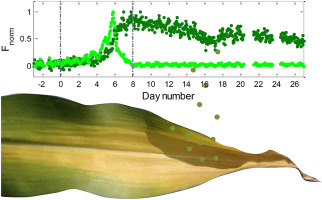当前位置:
X-MOL 学术
›
Atmos. Environ.
›
论文详情
Our official English website, www.x-mol.net, welcomes your
feedback! (Note: you will need to create a separate account there.)
Biogenic volatile organic compound emissions from senescent maize leaves and a comparison with other leaf developmental stages
Atmospheric Environment ( IF 4.2 ) Pub Date : 2018-03-01 , DOI: 10.1016/j.atmosenv.2017.12.020 A. Mozaffar , N. Schoon , A. Bachy , A. Digrado , B. Heinesch , M. Aubinet , M.-L. Fauconnier , P. Delaplace , P. du Jardin , C. Amelynck
Atmospheric Environment ( IF 4.2 ) Pub Date : 2018-03-01 , DOI: 10.1016/j.atmosenv.2017.12.020 A. Mozaffar , N. Schoon , A. Bachy , A. Digrado , B. Heinesch , M. Aubinet , M.-L. Fauconnier , P. Delaplace , P. du Jardin , C. Amelynck

|
Abstract Plants are the major source of Biogenic Volatile Organic Compounds (BVOCs) which have a large influence on atmospheric chemistry and the climate system. Therefore, understanding of BVOC emissions from all abundant plant species at all developmental stages is very important. Nevertheless, investigations on BVOC emissions from even the most widespread agricultural crop species are rare and mainly confined to the healthy green leaves. Senescent leaves of grain crop species could be an important source of BVOCs as almost all the leaves senesce on the field before being harvested. For these reasons, BVOC emission measurements have been performed on maize ( Zea mays L.), one of the most cultivated crop species in the world, at all the leaf developmental stages. The measurements were performed in controlled environmental conditions using dynamic enclosures and proton transfer reaction mass spectrometry (PTR-MS). The main compounds emitted by senescent maize leaves were methanol (31% of the total cumulative BVOC emission on a mass of compound basis) and acetic acid (30%), followed by acetaldehyde (11%), hexenals (9%) and m/z 59 compounds (acetone/propanal) (7%). Important differences were observed in the temporal emission profiles of the compounds, and both yellow leaves during chlorosis and dry brown leaves after chlorosis were identified as important senescence-related BVOC sources. Total cumulative BVOC emissions from senescent maize leaves were found to be among the highest for senescent Poaceae plant species. BVOC emission rates varied strongly among the different leaf developmental stages, and senescent leaves showed a larger diversity of emitted compounds than leaves at earlier stages. Methanol was the compound with the highest emissions for all the leaf developmental stages and the contribution from the young-growing, mature, and senescent stages to the total methanol emission by a typical maize leaf was 61, 13, and 26%, respectively. This study shows that BVOC emissions from senescent maize leaves cannot be neglected and further investigations in field conditions are recommended to further constrain the BVOC emissions from this important C4 crop species.
中文翻译:

衰老玉米叶片的生物挥发性有机化合物排放与其他叶片发育阶段的比较
摘要 植物是生物挥发性有机化合物(BVOCs)的主要来源,对大气化学和气候系统有很大影响。因此,了解所有丰富植物物种在所有发育阶段的 BVOC 排放非常重要。然而,即使是最广泛的农作物品种的 BVOC 排放调查也很少见,而且主要局限于健康的绿叶。粮食作物物种的衰老叶片可能是 BVOC 的重要来源,因为几乎所有的叶片在收获前都会在田间衰老。出于这些原因,已经对玉米(Zea mays L.)进行了 BVOC 排放测量,玉米是世界上栽培最多的作物物种之一,处于所有叶片发育阶段。使用动态外壳和质子转移反应质谱 (PTR-MS) 在受控环境条件下进行测量。衰老玉米叶片排放的主要化合物是甲醇(占化合物质量累积 BVOC 总排放量的 31%)和乙酸(30%),其次是乙醛(11%)、己烯醛(9%)和 m/ z 59 种化合物(丙酮/丙醛)(7%)。在化合物的时间排放曲线中观察到了重要的差异,黄化期间的黄叶和黄化后的干褐色叶被确定为与衰老相关的重要 BVOC 来源。发现衰老玉米叶子的总累积 BVOC 排放量是衰老禾本科植物物种中最高的。BVOC 排放率在不同叶片发育阶段之间差异很大,和衰老的叶子比早期的叶子显示出更大的排放化合物多样性。甲醇是所有叶片发育阶段排放量最高的化合物,幼生、成熟和衰老阶段对典型玉米叶片甲醇排放总量的贡献分别为 61%、13% 和 26%。本研究表明,衰老玉米叶片的 BVOC 排放不容忽视,建议在田间条件下进行进一步调查,以进一步限制这一重要 C4 作物品种的 BVOC 排放。典型玉米叶片的总甲醇排放量和衰老阶段分别为 61%、13% 和 26%。本研究表明,衰老玉米叶片的 BVOC 排放不容忽视,建议在田间条件下进行进一步调查,以进一步限制这一重要 C4 作物品种的 BVOC 排放。典型玉米叶片的总甲醇排放量和衰老阶段分别为 61%、13% 和 26%。本研究表明,衰老玉米叶片的 BVOC 排放不容忽视,建议在田间条件下进行进一步调查,以进一步限制这一重要 C4 作物品种的 BVOC 排放。
更新日期:2018-03-01
中文翻译:

衰老玉米叶片的生物挥发性有机化合物排放与其他叶片发育阶段的比较
摘要 植物是生物挥发性有机化合物(BVOCs)的主要来源,对大气化学和气候系统有很大影响。因此,了解所有丰富植物物种在所有发育阶段的 BVOC 排放非常重要。然而,即使是最广泛的农作物品种的 BVOC 排放调查也很少见,而且主要局限于健康的绿叶。粮食作物物种的衰老叶片可能是 BVOC 的重要来源,因为几乎所有的叶片在收获前都会在田间衰老。出于这些原因,已经对玉米(Zea mays L.)进行了 BVOC 排放测量,玉米是世界上栽培最多的作物物种之一,处于所有叶片发育阶段。使用动态外壳和质子转移反应质谱 (PTR-MS) 在受控环境条件下进行测量。衰老玉米叶片排放的主要化合物是甲醇(占化合物质量累积 BVOC 总排放量的 31%)和乙酸(30%),其次是乙醛(11%)、己烯醛(9%)和 m/ z 59 种化合物(丙酮/丙醛)(7%)。在化合物的时间排放曲线中观察到了重要的差异,黄化期间的黄叶和黄化后的干褐色叶被确定为与衰老相关的重要 BVOC 来源。发现衰老玉米叶子的总累积 BVOC 排放量是衰老禾本科植物物种中最高的。BVOC 排放率在不同叶片发育阶段之间差异很大,和衰老的叶子比早期的叶子显示出更大的排放化合物多样性。甲醇是所有叶片发育阶段排放量最高的化合物,幼生、成熟和衰老阶段对典型玉米叶片甲醇排放总量的贡献分别为 61%、13% 和 26%。本研究表明,衰老玉米叶片的 BVOC 排放不容忽视,建议在田间条件下进行进一步调查,以进一步限制这一重要 C4 作物品种的 BVOC 排放。典型玉米叶片的总甲醇排放量和衰老阶段分别为 61%、13% 和 26%。本研究表明,衰老玉米叶片的 BVOC 排放不容忽视,建议在田间条件下进行进一步调查,以进一步限制这一重要 C4 作物品种的 BVOC 排放。典型玉米叶片的总甲醇排放量和衰老阶段分别为 61%、13% 和 26%。本研究表明,衰老玉米叶片的 BVOC 排放不容忽视,建议在田间条件下进行进一步调查,以进一步限制这一重要 C4 作物品种的 BVOC 排放。











































 京公网安备 11010802027423号
京公网安备 11010802027423号